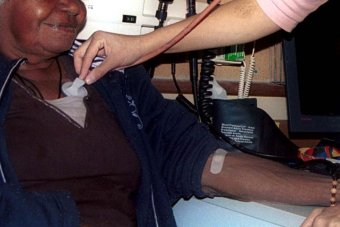
Visiting a doctor can be a difficult task for some Indigenous Australians but some health workers are trying to make it easier.
“Some of them rely on medicines from the bush I think and it is hard for them to come into the mainstream places to get white man’s medicine,” explained Andrea Mitchell, a Larrakia woman from Darwin.
“They do find it really hard to explain to a white person what their problem is and how to go about it.”
She said language and cultural barriers dissuaded some Indigenous people from visiting the doctor, which could lead to health conditions deteriorating.
Aboriginal and Torres Strait Islanders have a life expectancy of 69.1 years for men and 79.7 years for women – much lower than non-Indigenous Australians.
‘Common misconception that medicine is sugar pill’
But Indigenous health officers like Malcolm Laughton are working to change that.
His job at Aboriginal health service Danila Dilba is to speak with people before they see a doctor, to help them explain what is wrong and to ensure the contact is culturally appropriate.
He said initially Indigenous health officers were used when infectious diseases that required long-term treatment were more common, and Indigenous people from remote communities where they may not speak English may have needed someone to help them so treatment was more effective.
“It was a pivotal role in eradicating diseases such as leprosy,” Mr Laughton said.
“Every health worker has differing knowledge and differing connections through different parts of the NT and the different Aboriginal tribes and communities.
“This knowledge is used to get a good consult between the client and the Aboriginal health workers, to be able to treat successfully,” he said.
The role has gradually evolved and broadened over time.
When people saw him after coming out of hospital they sometimes had wrongly understood things they had been told, Mr Laughton explained.
“The first thing I ask them is ‘Do you know what this tablet is for?’
“A common misconception is that it is a sugar tablet, so when they don’t have the tablet, they can often just take sugar, which is actually the wrong story,” he said.
More attuned to culture
He also is attuned to cultural protocols.
“I think sometimes the consult definitely is cultural and sometimes spiritual-based and acknowledging these parts of people’s lives helps to get a better consult and make them feel comfortable,” Mr Laughton said.
“We always ask our clients firstly if it is myself, a male, and I have to screen a female I always ask ‘Would you like to see a female instead?’
For Ms Mitchell, going to see an Indigenous health worker makes her feel more comfortable when she has to see a doctor.
“I find it comfortable, as other Aboriginal people as well they would find it a little bit more comfortable talking to an Aboriginal liaison officer or practitioner before talking to say a non-Aboriginal person,” she said.
“It is better. I find it better to talk to an Aboriginal person because you feel they understand you better.”
By Kate Wild and Xavier La Canna
